The Lord God Is Manifested in the Incarnate Son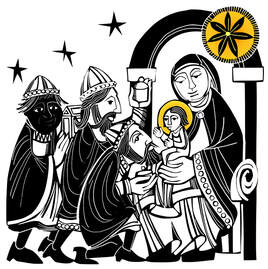
The Feast of the Epiphany centers in the visit of the Magi from the East. In that respect, it is a “Thirteenth Day” of Christmas; and yet, it also marks the beginning of a new liturgical season. While Christmas has focused on the Incarnation of our Lord—that is, on God becoming flesh—the season of Epiphany emphasizes the manifestation or self-revelation of God in that same flesh of Christ. For the Lord Himself has entered our darkness and rises upon us with the brightness of His true light (Is. 60:1–2). He does so chiefly by His Word of the Gospel, which He causes to be preached within His Church on earth—not only to the Jews but also to Gentiles (Eph. 3:8–10). As the Magi were guided by the promises of Holy Scripture to find and worship the Christ Child with His mother in the house (Matt. 2:5–11), so does He call disciples from all nations by the preaching of His Word, to find and worship Him within His Church (Is. 60:3–6). With gold they confess His royalty; with incense, His deity; and with myrrh, His priestly sacrifice (Matt. 2:11).
0 Comments
The Holy Spirit Gives Peace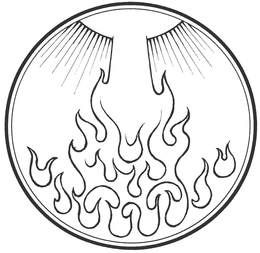
The Feast of Holy Pentecost, celebrated today, is also called “Whitsunday,” or “White Sunday.” This is a reference to the white robes of the newly baptized historically worn on this day. Yet, the liturgical color for today is red, the color of the Holy Spirit, taken from the fire that lit on the heads of the Eleven as the Spirit came. Pentecost is among the oldest observances of the Christian Church. As the second greatest Feast of Christendom, Whitsunday or Pentecost ranks only behind Easter in the Church's “Year of Grace.” Pentecost was observed as an Octave, meaning that the Feast took liturgical precedence over the subsequent seven days, as early as the 5th century A.D.
Following the flood, Noah’s descendants failed to spread out and fill the earth as God had spoken. Rather, they exalted themselves; with “one language and the same words” (Gen. 11:1) they spoke proudly and arrogantly. The Lord humbled them by confusing “the language of all the earth,” dividing and dispersing the people (Gen. 11:9). That dispersal was reversed on Pentecost Day (the fiftieth day of Easter), when God caused the one Gospel of the Lord Jesus Christ to be preached in a multitude of languages. “At this sound the multitude came together” (Acts 2:6), for the preaching of Christ is the primary work of the Holy Spirit, whereby He gathers people from all nations into one Church. The Holy Spirit teaches and brings to our remembrance the words of Jesus, which are the words of the Father who sent Him. These words bestow forgiveness and peace to those who keep and hold on to them in love for Jesus. “Peace I leave with you; my peace I give to you. Not as the world gives do I give to you. Let not your hearts be troubled, neither let them be afraid.” (John 14:27).
All Things Have Been Placed Under Jesus’ Feet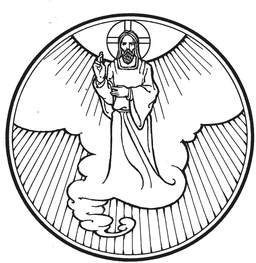
Forty days ago, the darkness of Lent was dispelled by the light of Easter. For forty days, the Church has cried, “Christ is risen! He is risen indeed!” But forty days after Jesus rose from the dead, he departed from his disciples and was enthroned in glory in heaven. From heaven he rules all things as our Lord and King. Today we celebrate the day he ascended (“went up”) to glory. But he promised not to leave his disciples alone. He promised to send them the Holy Spirit. They waited ten more days, and then on the Festival of Pentecost (“fiftieth day”) they saw Jesus’ promise made good. Ten days from today, we will celebrate that 50th day, the day of Pentecost.
Christ’s Resurrection Brings Us Life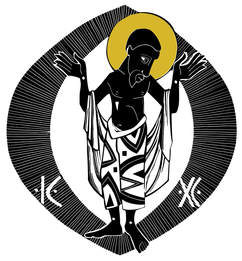
“Christ, our Passover lamb, has been sacrificed” (1 Cor. 5:7). By the shed blood of Christ, the Lamb of God, eternal death has passed over us. Now we pass with Christ through death into life everlasting. For Christ the crucified One is risen! The stone has been rolled away from the tomb, revealing that the tomb could not hold Him (Mk. 16:1–8). Now our Redeemer lives eternally to save us from sin and Satan and the grave, and we can live in the sure hope of our own bodily resurrection with Christ. “After my skin has been thus destroyed, yet in my flesh I shall see God” (Job 19:26). Feasting on the living Christ, who is our meat and drink indeed, we boldly say: “O death, where is your victory? O death, where is your sting?…But thanks be to God, who gives us the victory through our Lord Jesus Christ” (1 Cor. 15:54–55, 57).
The Paschal Candle is a special candle used at every service during the Easter season and at baptisms and funerals year-round. The Paschal Candle—rededicated last evening in our Easter Vigil service—symbolizes the resurrection victory over the darkness of sin and death. It emphasizes the presence of the resurrected Christ and the link between a believer’s baptism and the resurrection (Romans 6). The name Paschal comes from the Greek, pascha. Before the time of Christ, this word was used for Passover; after Christ, Christians took to using the word when referring to the Festival of the Resurrection (The term Easter came into use in later centuries). On the Paschal Candle are nails, symbolizing the wounds of Christ; a cross, the means by which we are saved through our baptism; two Greek letters, an Alpha [Α] and an Omega [Ω], which remind us of Jesus’ words in St. John’s Revelation (1:8; 22:13), and that he is the beginning and the end; and finally, the candle has the current year, the year of our Lord (“anno domini"; A.D.) 2017. Throughout the fifty days of Easter, the Paschal Candle traditionally stands near or in front of the altar as a symbol of resurrection. It is lighted for each service and is traditionally extinguished after the reading of the Gospel on Ascension. The Paschal Candle is of substantial size so its important symbolism speaks clearly. Even the stand in which it sits is of great size. As the Ad-vent candles bring wonderful meaning to the celebration of Advent, so the Paschal Candle is intended to add meaningful symbolism to our celebration of Easter, Baptisms, and Christian funerals.
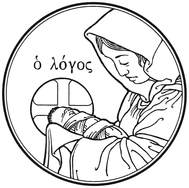
In the beginning God created all things through His Word, His Son. But man fell into sin, and with man all creation was cursed. Therefore, God spoke His Word again, this time into the womb of the blessed Virgin Mary. The glory of the Lord filled the tabernacle of our human nature (Ex. 40:17–21, 34–38, First Lesson). “The Word became flesh and dwelt among us” (John 1:1–14, Holy Gospel). The Son of God took on our flesh and blood and died on the cross in order that we might receive the right to become the children of God through faith. Baptized into Christ’s body, we are made partakers of a new Genesis, “the washing of regeneration and renewal of the Holy Spirit” (Titus 3:4–7, Second Lesson). In Christ, the kindness and love of God our Savior toward man has truly appeared.
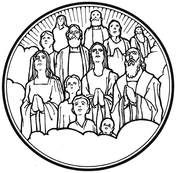
Last week, on Wednesday, November 1, the Church celebrated All Saints' Day. Today, we observe this feast. To “observe” a feast means we celebrate the feast day in a Divine Service not held on the specific day the feast is celebrated.
The Feast of All Saints’ is the most comprehensive of the days of commemoration, encompassing the entire scope of that great cloud of witnesses with which we are surrounded (Hebrews 12:1). It holds before the eyes of faith that great multitude which no man can number: all the saints of God in Christ––from every nation, race, culture, and language––who have come "out of the great tribulation...who have washed their robes and made them white in the blood of the Lamb" (Revelation 7:9, 14). As such, it sets before us the full height and depth and breadth and length of our dear Lord's gracious salvation (Ephesians 3:17-19). It shares with Easter a celebration of the resurrection, since all those who have died with Christ Jesus have also been raised with Him (Romans 6:3-8). It shares with Pentecost a celebration of the ingathering of the entire Church catholic–in heaven and on earth, in all times and places––in the one Body of Christ, in the unity of the Spirit in the bond of peace. Just as we have all been called to the one hope that belongs to our call, "one Lord, one faith, one baptism, one God and Father of all, who is over all and through all and in all" (Ephesians 4:4-6). And the Feast of All Saints shares with the final Sundays of the Church Year an eschatological focus on the life everlasting and a confession that "the sufferings of this present time are not worth comparing with the glory that is to be revealed to us" (Romans 8:18). In all of these emphases, the purpose of this feast is to fix our eyes upon Jesus, the author and perfecter of our faith, that we might not grow weary or fainthearted (Hebrews 12:2,3).
"I will pour out my Spirit." God’s Old Testament people celebrated the gathering of the harvest at the Festival of Weeks, or the Festival of Pentecost. In the New Testament, God sent the promised Counselor on the day we call “Pentecost,” Greek for “fifty,” because he sent the Holy Spirit fifty days after the Resurrection. This day marked the birthday of the New Testament Church and celebrates the harvest of souls won by the Son and gathered by his servants empowered by his Spirit. Pentecost is the third great festival (Nativity, Resurrection, Pentecost) of the Church and has been commemorated since at least 217 A.D. The Church dresses in red to remind us of the tongues of fire that marked the Spirit’s gift and the blood of the martyrs which was the seed of the Church. This day culminates the Season of Easter when our risen Lord now empowers his people to be witnesses of the resurrection for the world.
Forty days ago, the darkness of Lent was dispelled by the light of Easter. For forty days, the Church has cried, “Christ is risen! He is risen indeed!” But forty days after Jesus rose from the dead, he departed from his disciples and was enthroned in glory in heaven. From heaven he rules all things as our Lord and King. Today we celebrate the day he ascended (“went up”) to glory. But he promised not to leave his disciples alone. He promised to send them the Holy Spirit. They waited ten more days, and then on the Festival of Pentecost (“fiftieth day”) they saw Jesus’ promise made good. Next Sunday, we will celebrate that 50th day, the day of Pentecost.
CHRIST IS RISEN! HE IS RSEN INDEED! ALLELUIA! Sinners should fear God. Sinners ought to die for their wickedness. The grave should be the place of ultimate defeat for mankind. Yet on this day, the Second Adam did all that the first had left undone. Bearing our guilt and suffering our verdict, the Son of Man died, but three days later he rose in glory. As a result, fear is gone, mankind is redeemed, and Christ calls us his own brothers. Jesus came from death to life, and through baptism he brings us with him.
The enormous significance on Christ’s suffering, death, and resurrection has always been the central focus of Christian worship. Prior to the fourth century, Easter Day itself included all three emphases, but thereafter they were distributed over three days of special observance, which St. Augustine of Hippo called “the most holy triduum (“three days”) of the crucified, buried, and risen Lord.” These days have long been understood as the climax of the church’s year. We hope you notice the close connection between the three services of Maundy Thursday (Institution of the Lord’s Supper), Good Friday (Christ’s death), and Holy Saturday, known as the Vigil of Easter (Christ buried in the tomb). Each of these services connects, one into another. For this reason, all three services are included in this folder. This is also the reason that the service this evening, as well as tomorrow evening, does not include a blessing. That blessing will come at the end of the third service—Easter Vigil—which we will celebrate at sunrise on Easter morning.
|
Archives
February 2019
Categories
All
|
||||||||||||||||||||||||||||||||||||||||||||||||||||||||||||

 RSS Feed
RSS Feed
